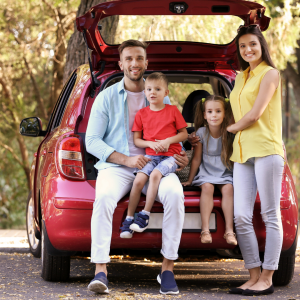
Remember the last time you were stranded in your car? It could be due to car failure, a flat tire, or just waiting in a traffic jam that seemed to take forever to clear. Nothing will make time slow to a crawl, and cause everyone to go crazy, like being stuck in a small place with nothing to do and no way to escape.
I have been stuck on the freeway for an extended period of time due to an accident. My emergency car kit kept me warm and hydrated. The only problem was a place to go to the bathroom!
Having a well-stocked emergency car kit can be a lifesaver, literally and figuratively. Here are some essential items to always have in your vehicle:
Check out our recommended products to ensure you have the best supplies on hand.
Emergency Plan and Routes
You should include a copy of your emergency plan in your emergency car kit. Be sure that you haven’t included any vital or financial information that could be problematic if stolen, since your car is more likely to be broken into than your home.
This kit should include a map of other possible routes to take to get home or to work. Make note on the map of your regular route, and mark the potential travel trouble spots (dams and bridges that could go out in a disaster, landslide areas, etc.), and have a plan for detours around these areas.
Kid Considerations (Pets TOO!)
 If you have children, they require some special considerations. As mentioned previously, entertainment is going to be one of your key issues in a disaster, especially in a car. Follow the same standards in food and entertainment as for your 72-hour kit.
If you have children, they require some special considerations. As mentioned previously, entertainment is going to be one of your key issues in a disaster, especially in a car. Follow the same standards in food and entertainment as for your 72-hour kit.
Do you need to customize your emergency car kits to include “parenting emergencies” – such as blowouts (not the tire kind), and car sickness? Having a change of clothes for the entire family becomes essential, along with garbage sacks to cover seats if needed.
If you have an infant, consider a breast pump and batteries – you will want to try and keep baby in their seat in case of an accident, even if you’ve just pulled over to the side of the road.
Your emergency entertainment kit should not have crayons; they will melt in the heat and leave a big mess. Include a permanent collection of games, books, and notepads in your car, with erasable markers or color pencils.
Be sure to have extra blankets. One picnic blanket isn’t going to cover the three rows of seats in your minivan. Plan accordingly or have individual emergency blankets in your car. Don’t forget the toilet paper!!
If you’re pregnant, then your supply list grows as well. You will need extra water, feminine supplies, maternity clothes, medical contacts, towels, and an emergency birthing kit (print and make your own from this link). I would also recommend a bowl that can be sealed for morning sickness or car sickness.
Other Ideas
This may not be part of the “kit” but having gas in your car at all times is pretty important. The general rule is ¼ tank of gas for cars. However, a van or suburban uses more gas than a car, so it’s even more important to keep it full. Try for closer to a ½ tank if possible. This is an important preparation for evacuations, after disaster fuel shortages, and if you get stuck in a snowstorm. That gas is going to keep your car moving for safety, waiting for recovery, or as a source of heat.
One consideration for your Emergency Car Kit is to take into account your usual route. If you have a big commute, then your car kit should be closer to a 72-hour kit or backpacking getup. You may also want to make an office emergency kit in case you have to shelter there. Either way, you’ll want to get home any way you can and that may mean walking out, so be prepared.
A small first aid kit will also be helpful in a pinch. You can make one for under $10 by purchasing first aid items from the dollar store or look for First Aid Kit Ideas (on Amazon).
Rotation
Temperature is one of the biggest factors in determining when you need to rotate your emergency supplies. Vehicles typically get much warmer or colder than office or home.
These extremes in temperature mean that you will need to take extra precautions and rotate food and water more frequently. If you store water in your car during summer’s extreme heat, the plastic bottles will deteriorate quicker, and your water will taste weird and be disgustingly hot. In the winter, that same water could freeze and burst, making a wonderful mess of your kit and car when you warm it up to go to work.
This is another reason why I recommend Emergency Water Pouches; they don’t leach, leak, or get warm. They really do stay cold and only need to be rotated every 5 years.
Any food you keep in your car will also go bad even faster, due to these temperature extremes. Set up a food rotating schedule for once a month in the summer, but rotate at least twice a year. Also check equipment for temperature warnings to avoid problems, particularly flammable items. These may need to be removed in the summer when the heat could cause an explosion.
Store Your Car Kit
How you store your Emergency Car Kit is important to your safety and preparation. There are many ways to store your emergency supplies in your car to prevent it from sliding around, getting lost, or causing an injury in an accident. You could keep a trunk – in your trunk – with your supplies inside. My family has a little bucket of basic supplies, and a backpack that we store ours in. Whatever you store it in, the important part is to have it safely contained and accessible, and to know where everything is so that you don’t have to clean out your car to find your supplies.
Today’s Challenge: Get Your Car Emergency Kit Ready